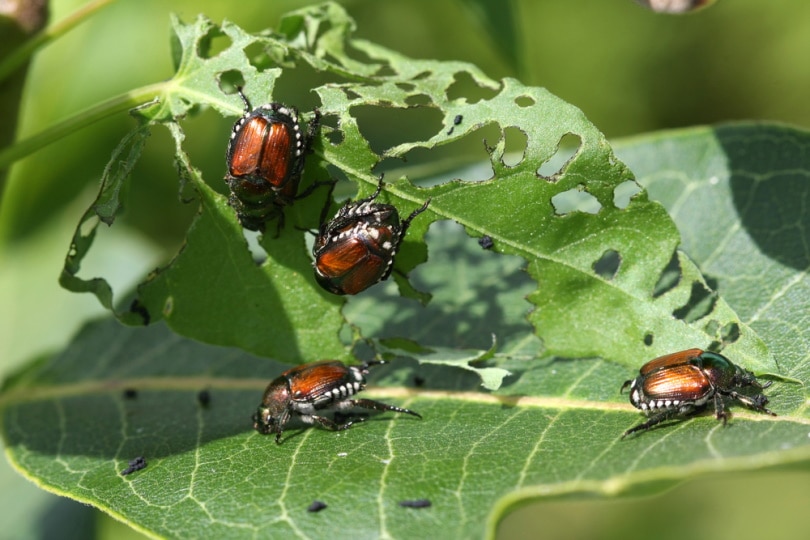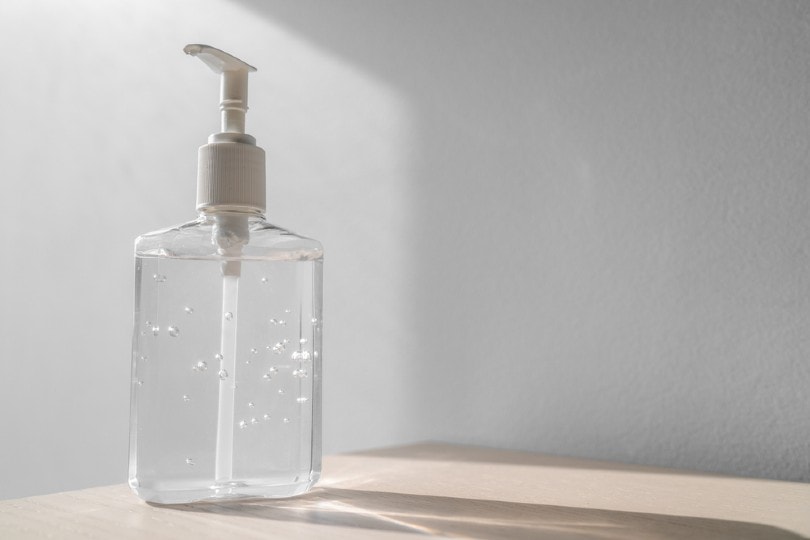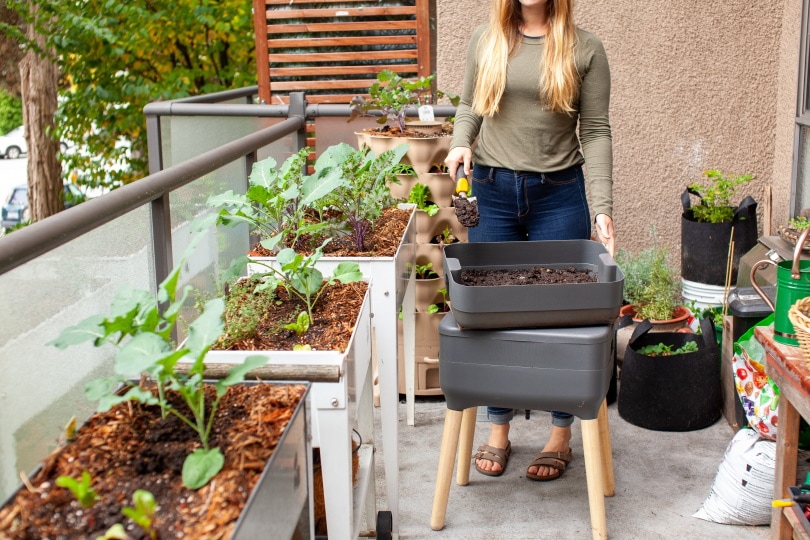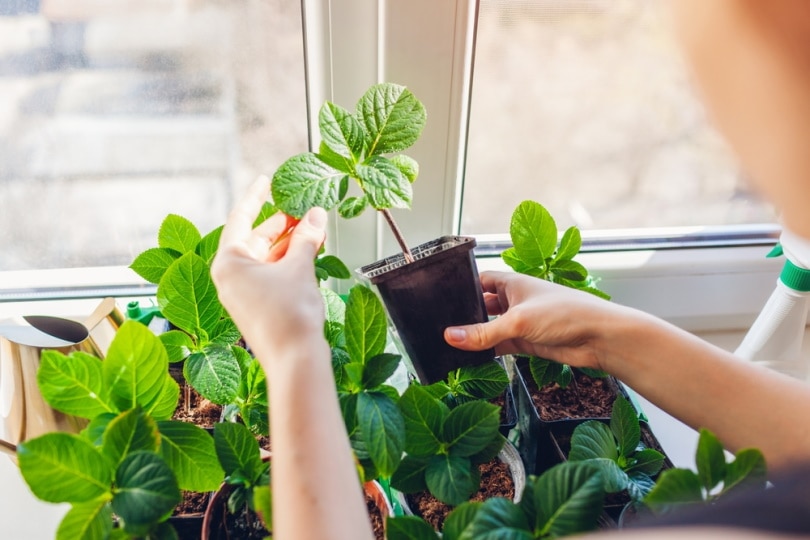How to Get Rid of Bugs in Houseplants: 7 Tips & Tricks
-
Shea Cummings
- Last updated:

There’s something ultra annoying about bugs infesting our indoor plants. Outside gardens are one thing; bugs and other pests are a part of the program. However, it’s war when it comes to bothering the plants in our living rooms.
Luckily, it’s not typically a difficult task to clear out common houseplant-loving bugs. This article goes through seven tips and tricks to get rid of them. It also explores several common pests you might encounter, so you know what you’re up against.
One thing to keep in mind when dealing with bugs or potential diseases on plants is to isolate the affected plant. This helps prevent the spread of whatever problem you’re trying to deal with.
The 7 Tips & Tricks to Get Rid of Bugs in Houseplants
1. Wash the Affected Plant
In many cases, washing the affected plant with dish soap or even a damp rag is enough to get rid of some pests like aphids. Other times, you may need to employ a more aggressive treatment and use insecticidal soap to kill the offending bugs.
Once you’ve isolated the plant, you can clean them every few days. Before long, you should notice the infestation beginning to dwindle. If it doesn’t, that’s when you’ll want to switch to the more aggressive insecticidal soap.
2. Rubbing Alcohol on a Cotton Swab

Another good option for some pests like scale or mealy bugs is a cotton swab dipped in rubbing alcohol. Rubbing alcohol may be a bit much for some more sensitive plants. In those cases, a swab dipped in vegetable oil will offer similar results.
3. Neem Oil Treatment
If you’re looking for a natural insecticide for your plants, neem oil is a great option. You can apply the oil to an active infestation to get rid of it. And you can also apply it to discourage the return of the bugs. Alternatively, you could also use a hot pepper spray for another natural solution or horticultural oil if you’re less concerned about “natural.”
4. Sticky Traps

For those pesky flying insects, yellow sticky traps are a superb option. If you have a larger infestation, a vacuum can sometimes give you the edge you need to get ahead of the invasion. When sucking them up, avoid getting too close to the leaves and sucking them up too.
5. Replace Soil
Many common pests you’ll deal with will lay eggs in or feed off the soil. So, changing the soil is a good idea if you’re dealing with recurring or stubborn infestations. This isn’t an ideal first line of offense against the pests, so you should try some other methods on this list first.
Proper storage of your unused potting mix is also important. Because there’s no point in changing to fresh soil if an infestation has already begun from improper storage. For example, using a 5-gallon bucket with a tight lid should do the trick.
6. Allow Soil to Dry

Fungus gnats are tiny flies that are similar to fruit flies. Eggs are laid in the soil, where their lives begin until they can annoy you by flying around. An effective method of eradicating them is to allow the top couple of inches to dry completely between watering. You could also try misting the soil’s surface with insecticidal soap if drying the soil doesn’t work.
7. Clean the Pot
In most situations, cleaning the pot is an essential part of the process. Bugs and their eggs can easily hide on or around the pot, and just when you think you’ve gotten rid of them, they’re back.
Additionally, cleaning up the area where a potted plant was sitting before you isolated it is also a good option. The bugs could reinfest the plant once you’ve cleaned it up and put it back.
 Common Bugs Found on Houseplants
Common Bugs Found on Houseplants
There are a lot of different bugs or pests you could be dealing with depending on where you live. But there are certainly some that are more common.
- Aphids: You’ve probably seen these tiny, sap-sucking bugs before. They commonly devour fresh growth and can reproduce very quickly as they have a short life span of only 2–3 weeks.
- White flies: Adult white flies are more annoying than anything. However, their young can do significant damage. They basically hang out on the underside of a plant’s leaves and feast on them. If left unchecked, their eating habits will cause the leaves to turn yellow and die, and the plant’s growth can be stunted from this as well.
- Mealybugs: These tiny bugs are similar to scale and leave a waxy film on the leaves and cause black sooty mold to grow on them. If left unchecked, these pests will kill your plant’s leaves and potentially stunt its growth.
- Fungus gnats: These bugs are similar to white flies in that the adults are more annoying than anything. In the same way, the larva stage has the potential to do more damage. Adult fungus gnats lay their eggs in the soil, then the larvae feed on the plant’s roots. This can cause all sorts of growth issues for the plants and potentially even kill them.
- Scales: Adults and immature scales both suck a plant’s sap. Typically, they will hang out on the underside of the leaves just like mealybugs, but they can also be found on the stems and topside of the leaves. Another troublesome thing about scales is that they leave a sticky residue called honeydew on the plant, which can attract ants.
- Spider mites: Arguably, one of the most annoying and troublesome infestations to get rid of is spider mites. These tiny critters are so small that they’re easy to miss. They often look like black specks on the leaves. Eventually, you’ll notice their white webs. If a plant becomes heavily affected by these pests, you may have to eliminate them before they spread. And you should always isolate the plant as soon as you notice spider mites on it.

Conclusion
Unfortunately, pests are often a part of being in a garden, indoors or out. At least most infestations aren’t terribly difficult to deal with. A lot of times, the bugs are more annoying than anything. However, if you’re dealing with something that will damage your plants, now you have the knowledge to deal with most issues quickly and successfully.
- See also: Which Fruits Are Best For Juicing?
Featured Image Credit: Ron Rowan Photography, Shutterstock
Contents

 Common Bugs Found on Houseplants
Common Bugs Found on Houseplants